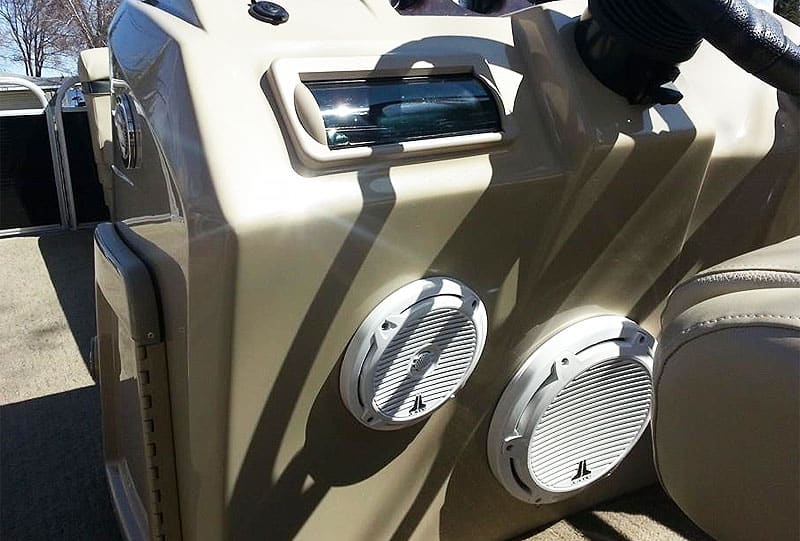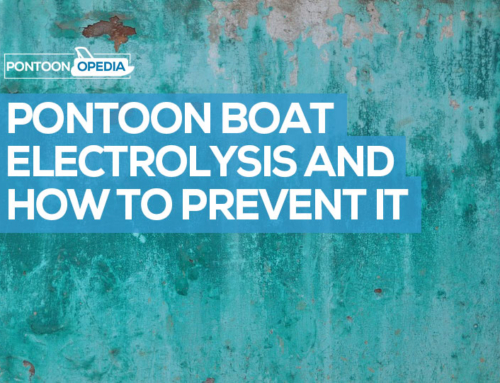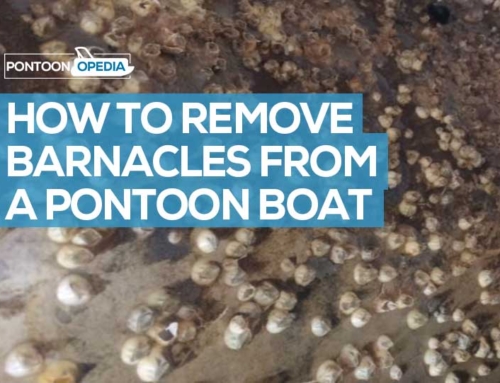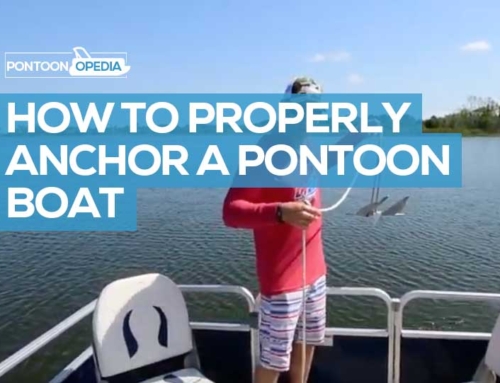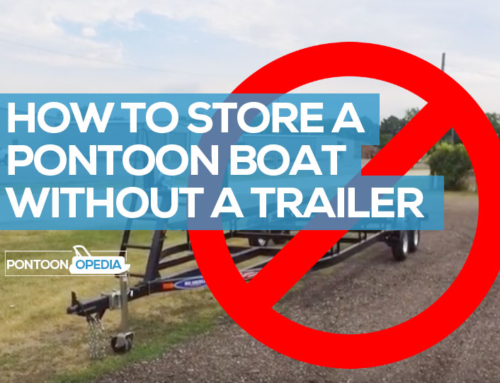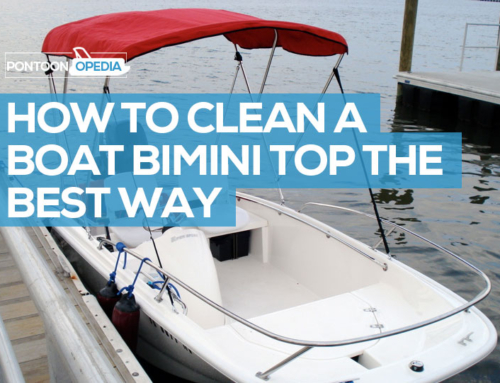(Image credit unknown, found when shared on Facebook.)
If you want a great sound in your pontoon boat and already have a marine stereo system installed, then you might want to consider installing a subwoofer. It will let you pump out some great low frequency bass volume to enhance the party vibe.
But, where’s the best place to install a subwoofer on your pontoon boat and will it make a difference where it is placed?
I personally don’t have a subwoofer installed in my pontoon boat but do have a couple of friends who have done this, and it will make a big difference depending on where you fit it.
It will very much depend on the layout and design of your boat, but most of the time the easiest place to install the subwoofer tends to be underneath the helm.
Table of Contents
Example Subwoofer Placements
Here are some photos showing some examples of how could fit a subwoofer into your pontoon boat, and where you would place it.
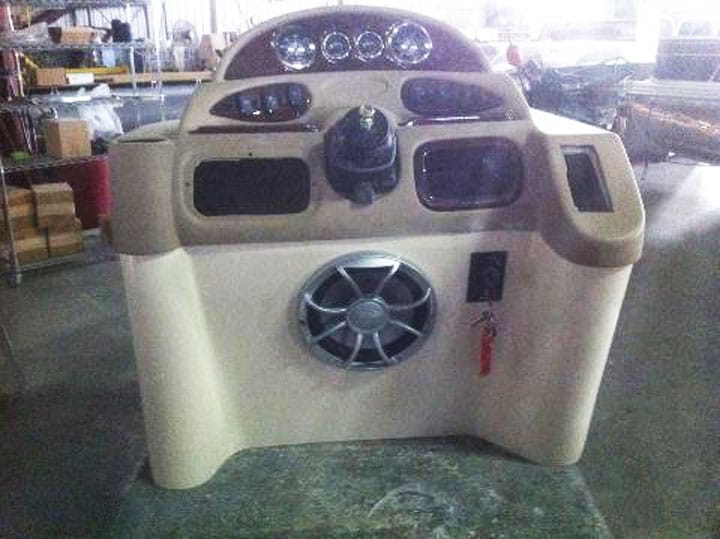
Here’s a classic example where the subwoofer has been fitted under the helm
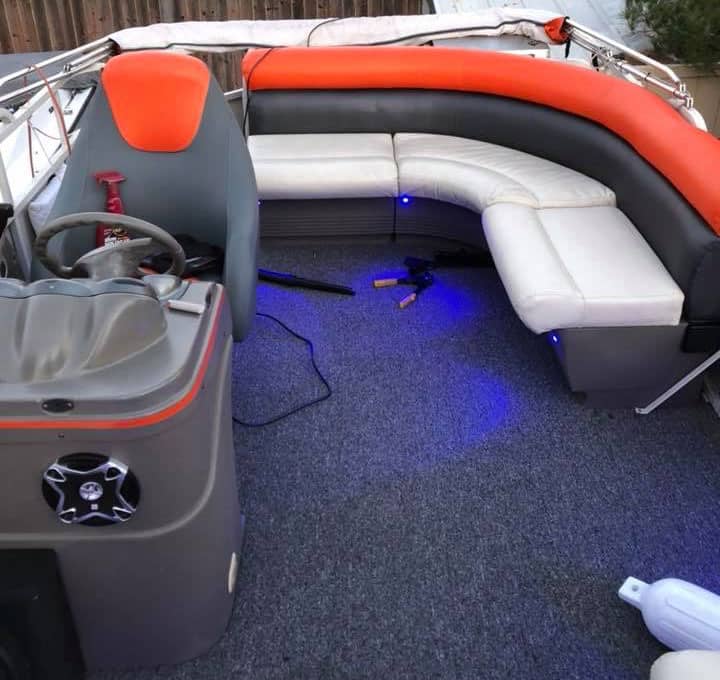
In this example the pontooners installed the subwoofer in front of the helm and one in rear behind the seats due to the interior layout (Image credit unknown, found shared on Facebook.)
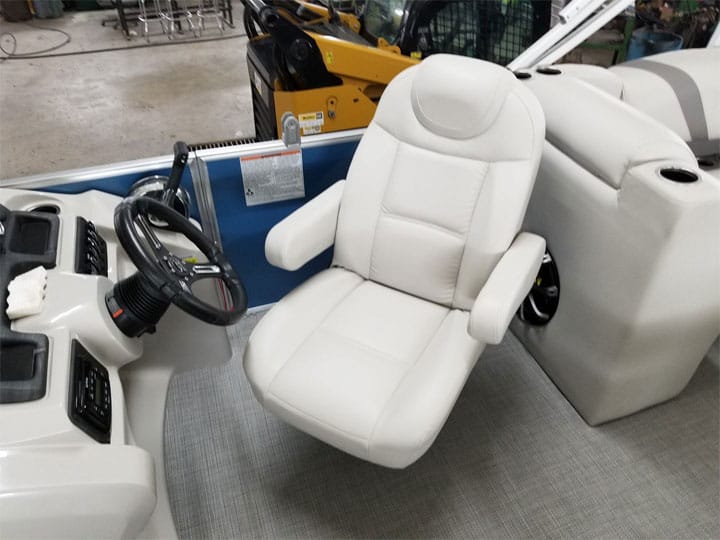
And here you can see a subwoofer installed right behind the actual helm seat. (Image credit unknown, found shared on Facebook.)
Things to Consider With Helm Installs
Things to consider with a helm placement is that you might not want the subwoofer aimed directly at you, but what you do have the benefit of is that it’s a convenient place as wiring should be easier than elsewhere on the pontoon.
The only other concern you might have is that it could rattle due to how you fit it and the plastic or fiberglass surrounds.
But, it is an easy to fit a subwoofer due to the access you will have to wiring and the large space you hopefully have inside. It will also be raised off the floor so chances of it getting wet is greatly reduced.
Under the Seats
If that’s going to be a problem, then what other pontooners have done is build a couple of boxes and place them under the seating. A good method is to have them firing down so that they don’t get exposed to water and also put one-inch riser feet on the boxes to allow for the air to flow underneath them.
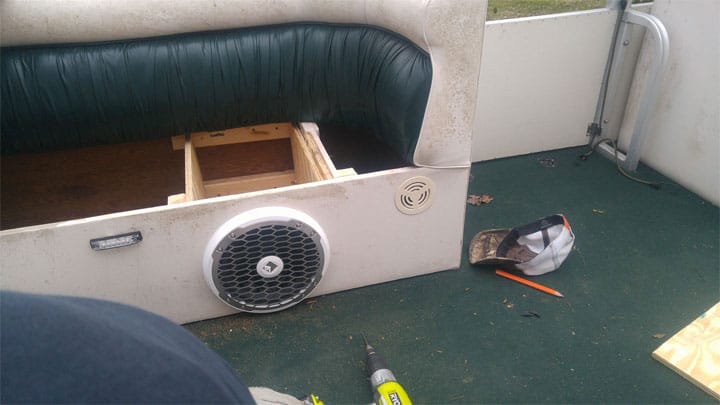
Alternatively you can fit a subwoofer under the pontoon seats.
How to Install Your Pontoon Boat Subwoofer
You have a few options here for mounting and installing. It’s possible to mount them with a baffle (free air) or inside of a box that you can even make yourself. Due to the nature of pontoon boat design, it might not be possible to find a place where you can fit a box.
Handy Hint: Most subwoofers manufactured for the marine industry are designed for baffle installation and free air mounting and won’t necessarily require a box.
If you do want to build your own box, then still choose a marine subwoofer as they are made with materials that will be salt and water resistant.
As I’ve mentioned, the best place to fit the subwoofer is in the front compartment or helm as it’s the most practical place. You will need to connect the subwoofer leads to your terminal.
Boxing a Subwoofer
When installing a subwoofer to your pontoon boat, make sure that you do build a box to mount it in. This will help to insulate it, keep it dry, and stop any rattling noises.
The cheapest way in which you can do this is to build an MDF wooden box and then coat it in resin or spray with Rhino liner. Use at least 5 coats of fiberglass resin as it will never rot and will become about 10 times harder than if not treated.
Here’s a shopping list from Amazon if you want to build one yourself with all the items below probably coming in at less than $100:
- Make the box from 3/4″ plywood or MDF
- 1/2 gallon fiberglass resin for boats (view on Amazon)
- Rollers or spreaders to put it on (view on Amazon)
- Box of screws
- Wire connector
Wiring the Subwoofer
There are two choices here if you are wiring yours up to an amplifier; in series or parallel.
Wiring in parallel is relatively straightforward as you just need to connect the positive leads from the subwoofer to the amplifier’s positive terminal, and the negatives leads to the negative terminal.
The benefit of parallel wiring is that you will reduce the resistance (impedance) thus will enhance the amplifier’s power.
Series wiring involves connecting the subwoofer’s positive leads to the amplifier’s positive terminal, but the difference is then that you connect the negative terminal of one subwoofer to the positive terminal of the second subwoofer.
Once that’s done, connect the second subwoofer’s negative terminal to the amplifier’s negative terminal. You then have to connect the amplifier to the pontoon boat’s battery with a power and ground wire.
If you have a power subwoofer, you will need to buy an amplifier kit for power, lead, and ground wires. Those wires will need to be connected to your pontoon’s system and battery.
What is the Best Subwoofer for a Pontoon Boat?
There are two different types here. You can get the powered ones where you don’t need to connect them to an external amplifier, or you can buy an unpowered one which will need an external marine amplifier in addition.
It’s also possible to buy specialist enclosed marine subwoofers which are bass tubes. These are completely water resistant and look like cylinders, that have the subwoofers built-in to them. You can probably pick up a subwoofer on Amazon for well under $200.
Here are just three that I recommend you check out, all of which have great online reviews. I believe these are the best you can buy.
Bazooka BTA6100 BT Series 100 Watts (Enclosed for Marine Use)
The best self-powered pontoon boat subwoofer I have seen I action is called a Bazooka tube (view on Amazon).
It is a 6-inch bass tube that are enclosed in a treated foam surround, outputting 100 watts. It comes straps for secure mounting and an on-board 2 channel amp, so you don’t need an additional amplifier when installing this one.
I like the enclosed marine subwoofers as they don’t require as much space, and you won’t have to build your own wooden MDF sealed box as described earlier in this article.
Bazooka 250 Watt Bass Tube (Enclosed for Marine Use)
For something with a little more power, I still recommend Bazooka as they seriously are the best enclosed marine subwoofers in the business. The 250 watts product will be more expensive (view on Amazon), but you’re going to get a far better bass sound.
They also look a load better than the cheaper model, with optional chrome plated UMS brackets if you want to spend a little bit more money.
Alpine Marine SWR-M100 300 Watts (Not Enclosed)
If you want subwoofers that aren’t enclosed, and you’re going to be building your own box using the method I outlined earlier, then there’s one product I recommend. You’ve probably heard of Alpine as they have a great reputation in the automotive market, but they now do specialist marine subwoofers.
The SWR-M100 (view on Amazon) is great value and offers superb sound quality with 300 watts of sound. The bass experience is just like what you might hear with a high-quality car stereo set-up.
Lastly: Be Respectful of Other Water Users
Whilst having a great sound system on your pontoon can really help to get the party started, please do I try and respect other users out boating.
Sound really does travel over water; for example, you can hear someone having a conversation from sometimes half a mile of a way on a still day. So, think about how the bass is going to travel with a subwoofer.
I’ve been out just by myself fishing for a quiet day on a lake, and you can hear boats with subwoofers coming from 5 miles away sometimes when they’ve got that bass volume pumping. It’s a bit annoying and not very respectful.
Rather than fit a subwoofer, you could instead invest in a better sound system which doesn’t require one.

